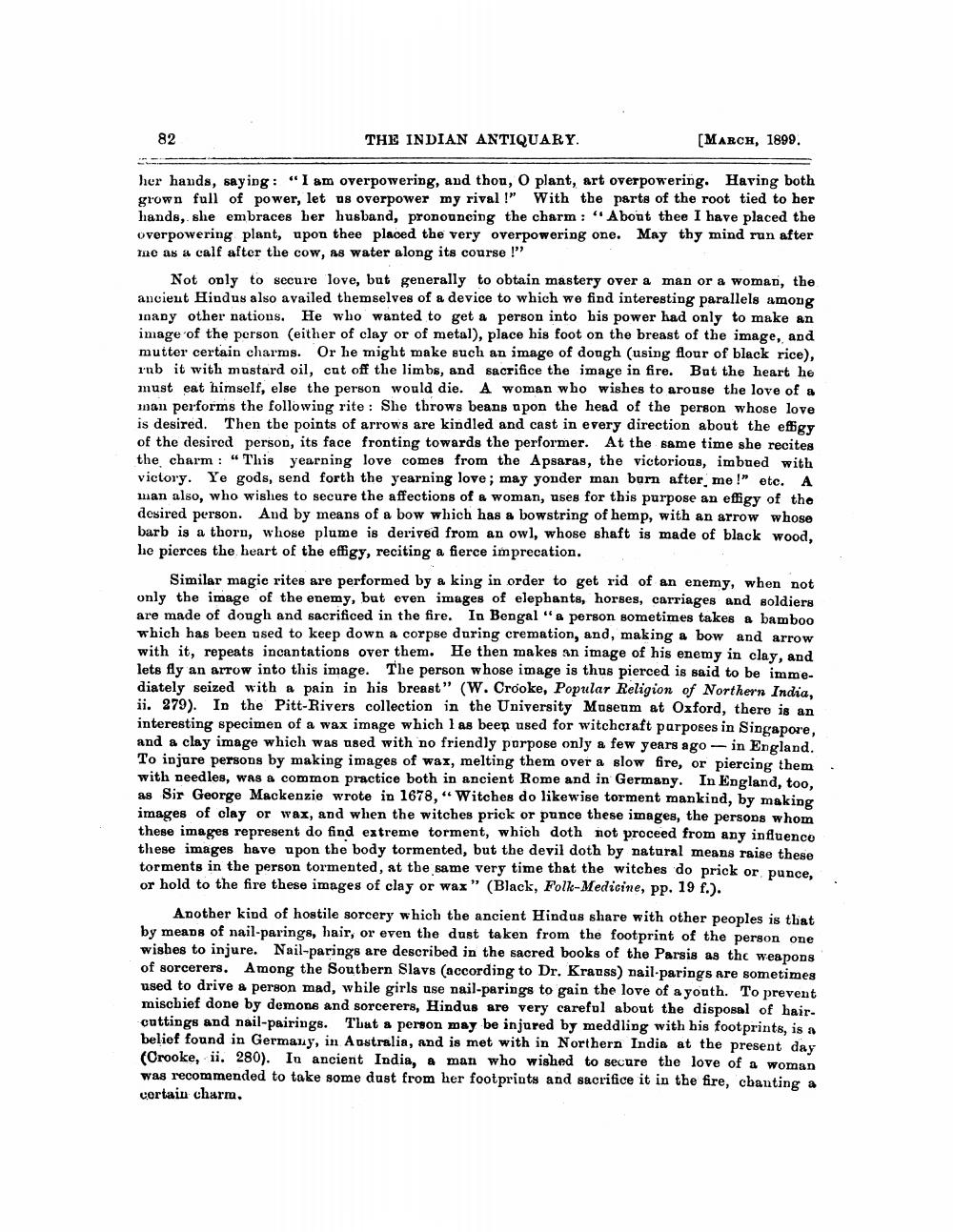________________
THE INDIAN ANTIQUARY.
[MARCH, 1899.
her hands, saying: "I am overpowering, and thou, O plant, art overpowering. Having both grown full of power, let us overpower my rival!" With the parts of the root tied to her hands, she embraces her husband, pronouncing the charm: "About thee I have placed the overpowering plant, upon thee placed the very overpowering one. May thy mind run after me as a calf after the cow, as water along its course!"
82
Not only to secure love, but generally to obtain mastery over a man or a woman, the ancient Hindus also availed themselves of a device to which we find interesting parallels among inany other nations. He who wanted to get a person into his power had only to make an image of the person (either of clay or of metal), place his foot on the breast of the image, and mutter certain charms. Or he might make such an image of dough (using flour of black rice), rub it with mustard oil, cut off the limbs, and sacrifice the image in fire. But the heart he must eat himself, else the person would die. A woman who wishes to arouse the love of a man performs the following rite: She throws beans upon the head of the person whose love is desired. Then the points of arrows are kindled and cast in every direction about the effigy of the desired person, its face fronting towards the performer. At the same time she recites the charm: "This yearning love comes from the Apsaras, the victorious, imbued with victory. Ye gods, send forth the yearning love; may yonder man burn after me!" etc. A man also, who wishes to secure the affections of a woman, uses for this purpose an effigy of the desired person. And by means of a bow which has a bowstring of hemp, with an arrow whose barb is a thorn, whose plume is derived from an owl, whose shaft is made of black wood, he pierces the heart of the effigy, reciting a fierce imprecation.
Similar magie rites are performed by a king in order to get rid of an enemy, when not only the image of the enemy, but even images of elephants, horses, carriages and soldiers are made of dough and sacrificed in the fire. In Bengal "a person sometimes takes a bamboo which has been used to keep down a corpse during cremation, and, making a bow and arrow with it, repeats incantations over them. He then makes an image of his enemy in clay, and lets fly an arrow into this image. The person whose image is thus pierced is said to be immediately seized with a pain in his breast" (W. Crooke, Popular Religion of Northern India, ii. 279). In the Pitt-Rivers collection in the University Museum at Oxford, there is an interesting specimen of a wax image which 1 as been used for witchcraft purposes in Singapore, and a clay image which was used with no friendly purpose only a few years ago - -in England. To injure persons by making images of wax, melting them over a slow fire, or piercing them with needles, was a common practice both in ancient Rome and in Germany. In England, too, as Sir George Mackenzie wrote in 1678, "Witches do likewise torment mankind, by making images of clay or wax, and when the witches prick or punce these images, the persons whom these images represent do find extreme torment, which doth not proceed from any influence these images have upon the body tormented, but the devil doth by natural means raise these torments in the person tormented, at the same very time that the witches do prick or punce, or hold to the fire these images of clay or wax" (Black, Folk-Medicine, pp. 19 f.).
-
Another kind of hostile sorcery which the ancient Hindus share with other peoples is that by means of nail-parings, hair, or even the dust taken from the footprint of the person one wishes to injure. Nail-parings are described in the sacred books of the Parsis as the weapons of sorcerers. Among the Southern Slavs (according to Dr. Krauss) nail-parings are sometimes used to drive a person mad, while girls use nail-parings to gain the love of a youth. To prevent mischief done by demons and sorcerers, Hindus are very careful about the disposal of haircuttings and nail-pairings. That a person may be injured by meddling with his footprints, is a belief found in Germany, in Australia, and is met with in Northern India at the present day (Crooke, ii. 280). In ancient India, a man who wished to secure the love of a woman was recommended to take some dust from her footprints and sacrifice it in the fire, chanting a certain charm.




